Movie Review – Kong: Skull Island
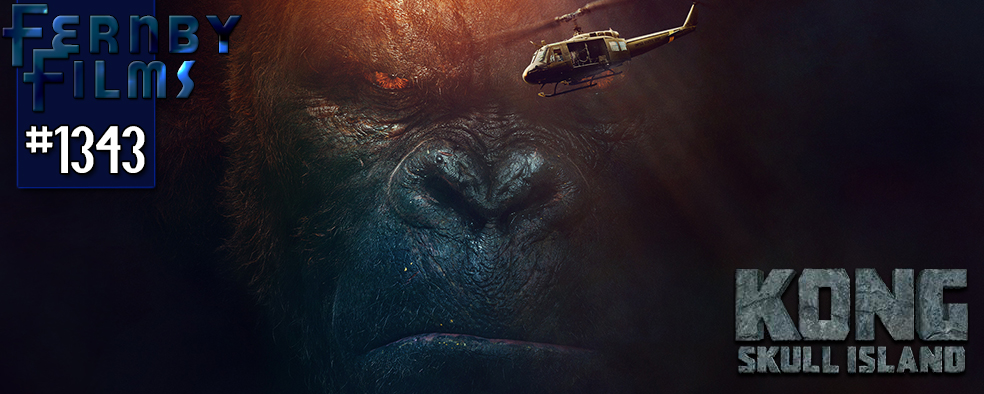
Director : Jordan Vogt-Roberts
Year Of Release : 2017
Principal Cast : Tom Hiddleston, Brie Larson, Samuel L Jackson, John Goodman, John C Reilly, Jing Tian, Toby Kebbell, John Ortiz, Corey Hawkins, Jason Mitchell, Shea Wigham, Thomas Mann, Terry Notary.
Approx Running Time : 118 Minutes
Synopsis: A team of scientists explore an uncharted island in the Pacific, venturing into the domain of the mighty Kong, and must fight to escape a primal Eden.
******
It legitimately surprised me to learn that Kong, the eponymous giant ape who debuted in 1933’s spectacular epic King Kong, has appeared in no fewer than 8 cinematic ventures in which his name is in the title, including the latest, Kong: Skull Island. Modern audiences will be familiar with Peter Jackson’s 3-hour remake of the ’33 original, peppered with bloat and lengthy human characterisations that made little impact, although to that point it was the most realistic Kong ever to grace the big screen. Sadly, it would be 12 long years between Jackson’s visit to Skull Island and this one, although time appears not to have been able to manufacture a decent sub-story on which to hang one of Hollywood’s true heavyweight icons. Sadly, while it boasts plenty of dynamite visual effects, and one of the coolest 70’s-era soundtracks in a film in many an age, Kong: Skull Island personifies the modern day blockbuster: empty characters and lifeless plotting crash headlong into raucous action sequences and bombast, brought to life by director Jordan Vogt-Roberts.
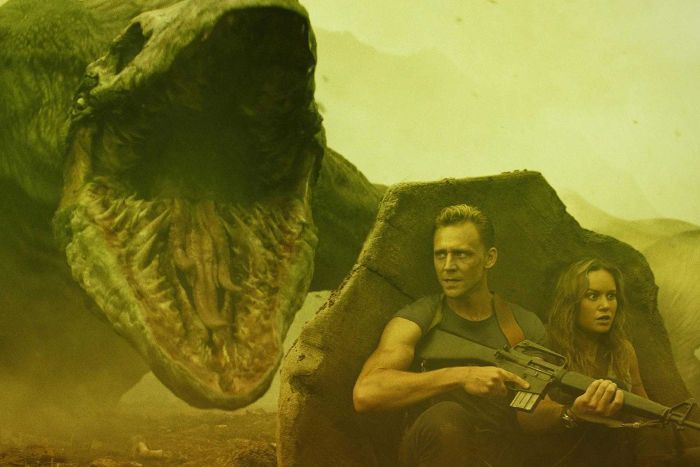 Plot synopsis courtesy Wikipedia: In 1973, former British Special Air Service Captain James Conrad (Tom Hiddleston) is hired by government agent Bill Randa (John Goodman) to guide an expedition to map out the island, known as “Skull Island”. Randa also recruits the Sky Devils, a helicopter squadron led by Lieutenant Colonel Preston Packard (Samuel L Jackson), to escort them to the island, and the group is soon joined by pacifist photojournalist Mason Weaver (Brie Larson), who believes the scientific expedition to be a cover for a crooked military operation and plans to expose it. Arriving on the island, the helicopters are quickly dispatched by a giant gorilla named Kong, leaving the survivors to trek across the creature-infested landscape to meet up with the extraction team. Along the way they meet a group of indigenous peoples, who have taken in former WWII pilot Hank Marlow (John C Reilly), who crashed on the island in 1944 and has been looking for a way off ever since.
Plot synopsis courtesy Wikipedia: In 1973, former British Special Air Service Captain James Conrad (Tom Hiddleston) is hired by government agent Bill Randa (John Goodman) to guide an expedition to map out the island, known as “Skull Island”. Randa also recruits the Sky Devils, a helicopter squadron led by Lieutenant Colonel Preston Packard (Samuel L Jackson), to escort them to the island, and the group is soon joined by pacifist photojournalist Mason Weaver (Brie Larson), who believes the scientific expedition to be a cover for a crooked military operation and plans to expose it. Arriving on the island, the helicopters are quickly dispatched by a giant gorilla named Kong, leaving the survivors to trek across the creature-infested landscape to meet up with the extraction team. Along the way they meet a group of indigenous peoples, who have taken in former WWII pilot Hank Marlow (John C Reilly), who crashed on the island in 1944 and has been looking for a way off ever since.
In its nascent state, Skull Island is the prototypical monster blockbuster. It sets up a mystery, gives us a gaggle of humans (most of whom we know are gonna die sometime during the ensuing carnage), and delivers hi-def thrills and effects in an effort to slobberknocker the audience into having a great time. If nothing else, Skull Island does just that. It’s certainly got plenty of thrills, and has a few nice humanistic beats hidden within its cacophonous walls. Yet the complaints often levelled at these shallow spectacle films rears its head here again; the human characters lack depth, development or empathy, with the possible exception of Sam Jackson’s Colonel Packard, who performs the unrelenting task of being the film’s primary antagonist when Kong takes down half his squadron.
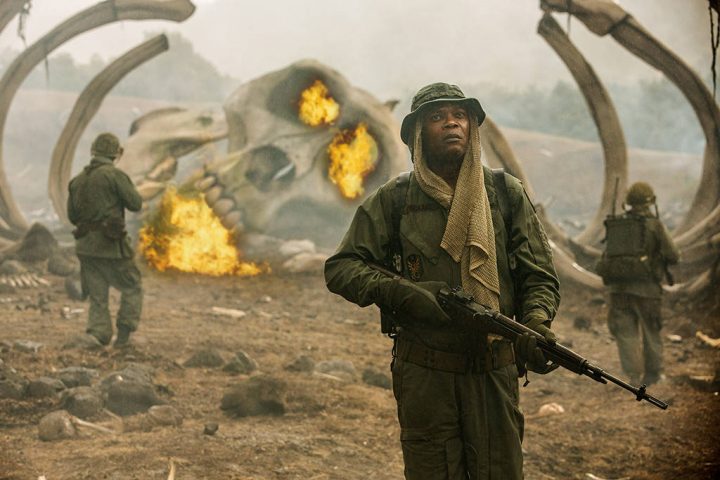 Tom Hiddleston’s “tracker” role, Conrad, is a not so subtle reference to Heart Of Darkness author Joseph Conrad, who wrote about men lost up a river (which is precisely part of Skull Island’s narrative) in the deep jungle, a “dark place” much like the aesthetic established in this film. Hiddleston, and by extension Conrad, is never a participant in the film, which is a surprise, but rather a passive watcher of all that transpires. It’s a confusing thing, really, giving a great actor like Hiddleston a role in which he achieves nothing, never grows as a person, and doesn’t even really “get the girl” to speak of. The girl in question, a supposed anti-war photojournalist who looks a lot like Brie Larson, is equally a passive observer, content throughout to simply look awestruck/shocked and take lots and lots of pictures. Neither Larson not Hiddleston have much to do other than watch as Kong takes the stage, with their characters having the personalities of melted butter and the interest of drying paint.
Tom Hiddleston’s “tracker” role, Conrad, is a not so subtle reference to Heart Of Darkness author Joseph Conrad, who wrote about men lost up a river (which is precisely part of Skull Island’s narrative) in the deep jungle, a “dark place” much like the aesthetic established in this film. Hiddleston, and by extension Conrad, is never a participant in the film, which is a surprise, but rather a passive watcher of all that transpires. It’s a confusing thing, really, giving a great actor like Hiddleston a role in which he achieves nothing, never grows as a person, and doesn’t even really “get the girl” to speak of. The girl in question, a supposed anti-war photojournalist who looks a lot like Brie Larson, is equally a passive observer, content throughout to simply look awestruck/shocked and take lots and lots of pictures. Neither Larson not Hiddleston have much to do other than watch as Kong takes the stage, with their characters having the personalities of melted butter and the interest of drying paint.
John Goodman’s role of Mr Exposition, Monarch’s chief scientist Bill Randa, starts strong as the film’s human focal point but quickly becomes pushed to the side as the group land on Skull Island. Goodman’s gravitas is wasted in what I assume is this film’s Carl Denham, a man obsessed with Kong but lacking fortitude when things hit the fan. Again, aside from setting up the mythology of Warner Bros’ cinematic MonsterVerse (a post-credit stinger reveals connections to a multitude of leviathan kaiju, including Godzilla), there’s little for him to do with his character that involves personal growth or attachment with the audience. Sam Jackson’s Packard goes batshit crazy enough for three films, zealously intent on killing Kong for the destruction of his squad, despite knowledge that Kong is the only thing standing between human survival and human extinction. Jackson, as well as contemporary John C Reilly, who provides the lion’s share of laughs in this film, are Skull Island’s best human creations, which is problematic given they’re secondary ones at best.
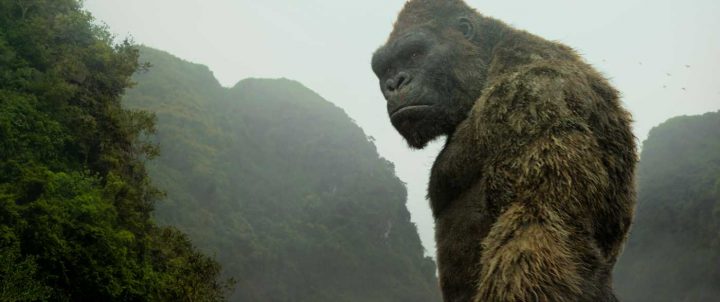 The reason you watch a film like Skull Island is, obviously, to see its title-carrying star in action. And Kong, brought to digital life by a mo-capped Terry Notary (The Hobbit, Planet Of The Apes) and the CG wizards at ILM, is everything you could hope for. He arrives early in the film, and delivers some truly remarkable beat-downs on both human helicopters and creatures from a hidden netherworld beneath the surface (the “Hollow Earth” principle forms the basis for the MonsterVerse), enough to resurrect a floundering human narrative with punch and weight. The classic beauty-and-beast motif of previous films, in which Kong forms an attachment to the traditionally blonde leading lady, is jettisoned in favour of a more protective mantra for the giant ape; he protects those on the island, and sees Packard’s seismic explosions as something to be attacked – basically, soldiers shooting before thinking is the unsaid lesson we all learn here, again – and thus setting the plot in motion. Vogt-Roberts’ Kong is a true giant of the screen, standing 100 feet tall (far taller than any previous Kong I’m aware of) while walking upright like a man (accentuating said height, I guess), and bearing the scars of many a battle following the death of his parents (alluded to in a sidebar with Marlow, before becoming a central element in one of the film’s more thrilling sequences).
The reason you watch a film like Skull Island is, obviously, to see its title-carrying star in action. And Kong, brought to digital life by a mo-capped Terry Notary (The Hobbit, Planet Of The Apes) and the CG wizards at ILM, is everything you could hope for. He arrives early in the film, and delivers some truly remarkable beat-downs on both human helicopters and creatures from a hidden netherworld beneath the surface (the “Hollow Earth” principle forms the basis for the MonsterVerse), enough to resurrect a floundering human narrative with punch and weight. The classic beauty-and-beast motif of previous films, in which Kong forms an attachment to the traditionally blonde leading lady, is jettisoned in favour of a more protective mantra for the giant ape; he protects those on the island, and sees Packard’s seismic explosions as something to be attacked – basically, soldiers shooting before thinking is the unsaid lesson we all learn here, again – and thus setting the plot in motion. Vogt-Roberts’ Kong is a true giant of the screen, standing 100 feet tall (far taller than any previous Kong I’m aware of) while walking upright like a man (accentuating said height, I guess), and bearing the scars of many a battle following the death of his parents (alluded to in a sidebar with Marlow, before becoming a central element in one of the film’s more thrilling sequences).
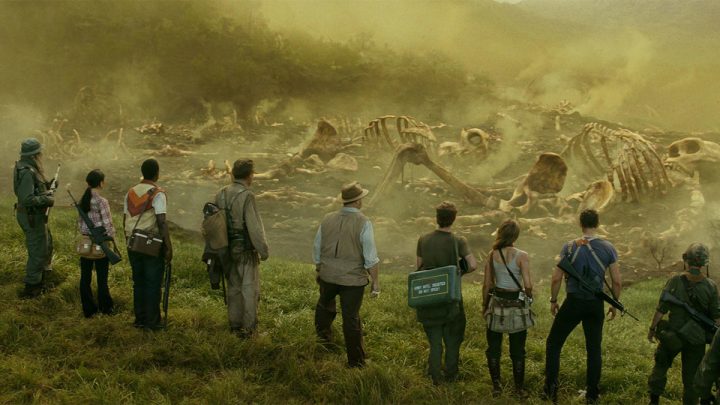 Look, in spite of all this, I did have a great time with Skull Island. It doesn’t pretend to be something it isn’t (unlike Jackson’s, which went too heavy with dramatic lethargy when it should have zinged with action-packed alacrity) and has some genuinely thrilling action sequences to keep you both shocked and awed. The production design, from costumes and visual effects, to landscape photography and a soundtrack filled with instantly iconic 70’s radio tunes, are first-rate, mixing green-screen and practical work in a blend that’s altogether seamless. Vogt-Roberts’ direction is designed purely around spectacle, offering angles and camerawork that afford the most bang-for-the-buck and giving Skull Island as dynamic a visual palette as is possible. The PG13-rated violence, echoing Spielberg’s Jurassic Park franchise in many ways, is visceral without being gory, with several characters’ deaths evoking some chuckles from the guys in my audience, and gasps from the women.
Look, in spite of all this, I did have a great time with Skull Island. It doesn’t pretend to be something it isn’t (unlike Jackson’s, which went too heavy with dramatic lethargy when it should have zinged with action-packed alacrity) and has some genuinely thrilling action sequences to keep you both shocked and awed. The production design, from costumes and visual effects, to landscape photography and a soundtrack filled with instantly iconic 70’s radio tunes, are first-rate, mixing green-screen and practical work in a blend that’s altogether seamless. Vogt-Roberts’ direction is designed purely around spectacle, offering angles and camerawork that afford the most bang-for-the-buck and giving Skull Island as dynamic a visual palette as is possible. The PG13-rated violence, echoing Spielberg’s Jurassic Park franchise in many ways, is visceral without being gory, with several characters’ deaths evoking some chuckles from the guys in my audience, and gasps from the women.
Skull Island is stuck with a gaggle of bland characters who have barely anything to do other than look off-screen socked and amazed. This limitation on a cast of seasoned pros is disappointing, in much the same way we were all annoyed with Roland Emmerich’s Godzilla for doing much the same thing. But unlike that Godzilla, Skull Island surges whenever Kong (or the cavalcade of other monsterous beasties) appears on the screen, enjoying the sonic bombast and visual spectacle modern cinema can muster with a sense of thrill and near-death escape. Comparisons between Skull Island and the original King Kong are to be ignored: they’re films from different eras. This Kong shakes, rattles and rolls your local multiplex auditorium with pulse-pounding fight sequences against a rock-infused soundtrack and a tone similar to Apocalypse Now, and while I lament the lack of human characters being less enthusiastic than planks of timber, Skull Island is magnificently overwrought as only the best monster films can be.



